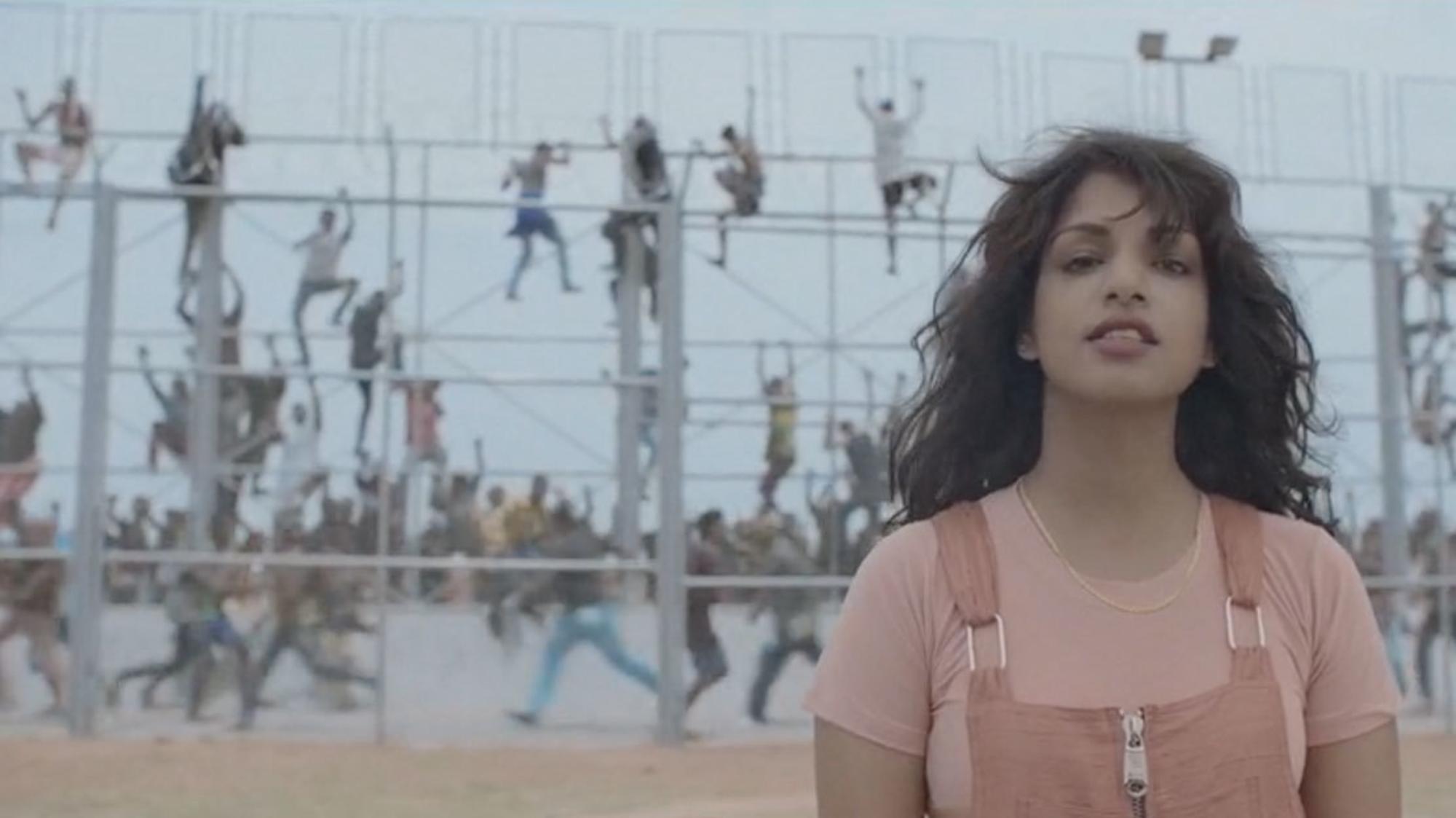MATANGI / MAYA / M.I.A.
and The Tyranny of Hope
and The Tyranny of Hope
This article first appeared on degreecritical.com

In the music video for her song “Paper Planes” (2007), the rapper M.I.A. delivers a kebab sandwich from a New York City halal food truck to a passerby as she sings: “All I want to do is [three gunshots] and take your money.” It’s a play on xenophobic fears of the immigrant—represented here by the halal food truck, and the paper plane, a metaphor for a travel visa—who arrives in another country and takes the job of a native who supposedly deserves it more. But her lyrics clash with the image: Selling street food is quite different from holding someone up at gunpoint. M.I.A. hands over the sloppily wrapped sandwich and the viewer is left wondering about the tyranny of hope, about the way certain stories are expected to achieve a particular resolution, and about the painful act of reducing oneself to a narrative worthy of consumption.
The tyranny of hope lies in the sadistic comfort we take in the idea that the mind-numbing motions of day-to-day life are worthwhile. We tell ourselves that it is why we keep going, why we write, why artists produce, why they continue to push these things out of themselves. We say that hope is what drives us to define ourselves, in spite of the stories that others may tell about us.

Still from MATANGI / MAYA / M.I.A. (2018). Courtesy of Cinereach / Abramorama.
Loveridge’s documentary relies on a mixture of media footage and extensive, almost obsessive, home videos that M.I.A. herself shot over the past twenty years. Through this mish-mash of film clips, it becomes clear that Loveridge has struggled to reconcile the rapper’s contradictory and expansive history. The narrative rarely relies on voiceover, but in one of the few instances where it is used, M.I.A. tells the audience: “As a first-generation person, I’ve lived through a war, came as a refugee, that is now a pop star. What are the goalposts? It’s amazing that in one lifetime you have to come and figure out so many things, but I’ve made it all fit together.”
M.I.A. troubles the mainstream media because there is no convenient format to tell the story of a refugee-turned-pop star. Hers is the story of a self-made artist, whose unapologetic and at times abrasive rap tunes, compelling political lyrics, and DIY guerrilla style challenges a global cultural moment. It’s a simultaneous tale of a teenage immigrant dealing with culture shock in a new country, the drama of her troubled lineage, and learning to survive with this dual existence. “If you come from the struggle, how the fuck do you talk about the struggle without talking about the struggle?” she protests in the film. It is also the story of the activist M.I.A., who utilizes her position as a famous pop star to shed light on the ongoing violence and turmoil in her home country, and the plight of immigrants and refugees worldwide. Still, none of these storylines or angles manages to capture the full picture of the fearless, defiant, self-described “bona fide hustler” who has continuously challenged pop culture. Throughout her musical career, she has been shunned by the press for reimagining real-life film footage of children being shot in the head in the video for her 2010 song “Born Free” (trading in kids from Third World nations for ginger-haired boys, and blood for ketchup), having her consumption of truffle fries be read out of context1, and upstaging Madonna by flipping her middle finger to the cameras during the 2012 Super Bowl halftime show.
Why do we tend to repudiate artists and their struggles as soon as they become rich or famous? Must an artist continually suffer for his or her plight to be validated? Why can’t we accept one’s need to express and appreciate the beauty and heartache this contains? Sociologist Avery Gordon examines these problems in her book Ghostly Matters: Haunting and the Sociological Imagination (1997), in which she discusses how historically marginalized people are denied the concept of complex personhood:
Complex personhood means that even those called “Other” are never just that. Complex personhood means that the stories people tell about themselves, about their troubles, about their social worlds, and about their society’s problems are entangled and weave between what is immediately available as a story and what their imaginations are reaching toward.In his film, Loveridge half-jokingly asks: “Maya, why are you such a problematic artist? Why don’t you just–” She cuts him off. “Shut up? Why don’t I just shut up and make a hit?” This is the act of a self, adhering to the tyranny of hope and conscious of wanting to be expressed, while also being aware of the limitations society is trying to force upon her. Her fierce, overwhelming, furious need to say “I’m here, I have something to tell you, and you will listen” is a statement of ownership of her presupposed victimhood—a victimhood that has legitimized both her struggles and her successes. M.I.A.’s complex personhood, and her need to be read outside of the margins, to be conceived of outside of categories, and to remain open-ended, is in and of itself powerful, political, and revolutionary.
It is very much unlike M.I.A. to let others speak on her behalf. After all, she has always authored her own image, aesthetics, and the style of her music videos. Perhaps it is for this reason that Loveridge decided to stitch together footage of a young Maya speaking directly to the camera. Because of his resignation from full authorship of the documentary, instead allowing for the artist’s own words and images to prevail, we can begin to peel away the layers of her complex story. While Loveridge’s film shies away from being a typically constructed documentary about an artist’s musical career, it instead sheds light on the human need to express oneself, in whichever way, shape or form, and to use whatever platform necessary in order to voice that expression. The film shows a rare instance where one person’s victimhood is blatantly owned, making Matangi, Maya, and M.I.A.—in her own words—“interesting.”
__________
[1] In Lynn Hirschberg’s profile “M.I.A. Agitprop Pop,” published in The New York Times Magazine on May 25, 2010, the author took one of M.I.A.’s actions during their interview, eating a truffle-flavored French fry (which Hirschberg and the newspaper had provided to the artist) and erroneously described it as having taken place while the singer spoke about being an outsider: “Unity holds no allure for Maya — she thrives on conflict, real or imagined. ‘I kind of want to be an outsider,’ she said, eating a truffle-flavored French fry. ‘I don’t want to make the same music, sing about the same stuff, talk about the same things. If that makes me a terrorist, then I’m a terrorist.’” This mischaracterization of her words and actions resulted in critical backlash at the time and is discussed in MATANGI / MAYA / M.I.A. as an example of how the mainstream media set out to portray the rapper as a hypocrite: someone who talks about being an outsider while enjoying the comforts of wealth.
